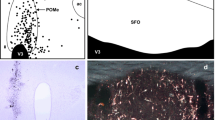Summary
The paraventricular organ (PVO) and the posterior recess organ (PRO) of two elasmobranch species, the spiny dogfish,Squalus acanthias, and the skate,Raja radiata, were investigated by use of scanning and transmission electron microscopy and immunocytochemistry employing a series of primary antisera. The PVO and PRO contained four types of cerebrospinal fluid (CSF)-contacting neurons. One type was free of secretory granules and projected a dendrite-like process into the ventricle. The other three types were distinguished according to the size of their secretory granules. The ventricular extensions of these cells were filled with secretory granules. By means of immunocytochemistry three types of CSF-contacting neurons were observed in the PVO and PRO. Type I contained only serotonin; type 2 displayed only somatostatin; type 3 was endowed with both serotonin and somatostatin. Type I dominated in the PRO, whereas type 3 was the most frequent in the PVO. The latter cells appear to be the site of origin of a loose tract formed by serotonin- and somatostatinimmunoreactive fibers projecting from the PVO into the neuropil of the PRO. Compact bundles formed exclusively by serotonin fibers were also shown to extend between the PVO and PRO. The basal processes of the CSF-contacting neurons of the PRO penetrated into the underlying neuropil. This neuropil is rich in synapses and can be regarded as an integrative area to which the basal processes of the local CSF-contacting neurons, serotonin and somatostatin fibers from the PVO, and fibers containing immunoreactive thyrotropin-releasing hormone of unknown origin, support a conspicuous input. The present findings indicate that the PVO and PRO of elasmobranchs are functionally integrated structures.
Similar content being viewed by others
References
Charlton HH (1928) A gland-like ependymal structure in the brain. Proc K Ned Akad Wet Amsterdam 31:823–836
Ekström P, van Veen Th (1982) The monoaminergic paraventricular organ in the teleostIctalurus nebulosus Le Sueur, with special reference to its vascularization. Acta Zool (Stockh) 63:45–54
Ekström P, van Veen Th (1984) Distribution of 5-hydroxytryptamine (serotonin) in the brain of the teleostGasterosteus aculeatus L. J Comp Neurol 226:307–320
Evan AP, Saland LC, Demski LS (1976) The structure of the hypothalamic inferior lobes of the blacktip reef shark: Scanning and transmission electron microscopic observations. J Morphol 150:59–78
Fänge R, Östlund E (1954) The effects of adrenaline, noradrenaline, tyramine and other drugs on the isolated heart from marine vertebrates and a cephalopod (Eledone cirrosa). Acta Zool (Stockh) 35:289–305
Fryer JN, Boudreault-Chateauvert C, Kirby RC (1985) Pituitary afferents originating in the paraventricular organ (PVO) of the goldfish hypothalamus. J Comp Neurol 242:475–484
George SR, Meissl H (1987) An attempt to record neuronal activity in the paraventricular organ ofRana esculenta by means of a direct access to the infundibular recess. Cell Tissue Res 250:53–56
Gonzalez CB, Rodríguez EM (1980) Ultrastructure and immunocytochemistry of neurons in the supraoptic and paraventricular nuclei of the lizardLiolaemus cyanogaster. Evidence for the intracisternal location of the precursor of neurophysin. Cell Tissue Res 207:463–477
Kah O, Chambolle P (1983) Serotonin in the brain of the goldfish,Carassius auratus. An immunocytochemical study. Cell Tissue Res 234:319–333
Kamer JC van de, Verhagen TG (1954) The cytology of the neurohypophysis, the saccus vasculosus and the recessus posterior inScyliorhinus caniclus. Proc K Ned Akad Wet Ser C Biol Med Sci 57:358–364
Kiss JZ, Péczély P (1987) Distribution of tyrosine-hydroxylase (TH)-immunoreactive neurons in the diencephalon of the pigeon (Columba livia domestica). J Comp Neurol 257:333–346
Long DM, Bodenheimer TS, Hartmann JM, Klatzo I (1968) Ultrastructural features of the shark brain. Am J Anat 122:209–235
Margolis-Kazan H, Halpern-Sebold LR, Schreibman MP (1985) Immunocytochemical localization of serotonin in the brain and pituitary gland of the platyfish,Xiphophorus maculatus. Cell Tissue Res 240:311–314
Meredith Gloria E, Smeets WJAJ (1987) Immunocytochemical analysis of the dopamine system in the forebrain and midbrain ofRaja radiata: Evidence for a substantia nigra and ventral tegmental area in cartilaginous fish. J Comp Neurol 265:530–548
Meurling P (1967) The vascularization of the pituitary in elasmobranchs. Sarsia 28:1–104
Olivereau M, Ollevier F, Vandesande F, Olivereau J (1984) Somatostatin in the brain and the pituitary of some teleosts. Immunocytochemical identification and the effect of starvation. Cell Tissue Res 238:289–296
Peute J (1969) Fine structure of the paraventricular organ ofXenopus laevis tadpoles. Z Zellforsch 97:564–575
Ritchie TC, Livingston CA, Hughes MG, McAdoo DJ, Leonard RB (1983) The distribution of serotonin in the CNS of an elasmobranch fish: Immunocytochemical and biochemical studies in the Atlantic stingray,Dasyatis sabina. J Comp Neurol 221:429–443
Rodríguez EM, Yulis R, Peruzzo B, Alvial G, Andrade R (1984) Standardization of various applications of methacrylate embedding and silver methenamine for light and electron microscopy immunocytochemistry. Histochemistry 81:253–263
Smeets WJAJ, Nieuwenhuis R, Roberts BL (1983) The central nervous system of cartilaginous fishes. Springer, Berlin Heidelberg New York
Sternberger LA, Hardy PH, Cuculis Jr JJ, Meyer HG (1970) The unlabeled antibody enzyme method for immunohistochemistry. Preparation and properties of soluble antigen-antibody complex (horseradish peroxidase-anti peroxidase) and its use in identification of spirochetes. J Histochem Cytochem 18:315–333
Vigh B (1971) Das Paraventrikularorgan und das zirkumventrikuläre System des Gehirns. Studia Biol Acad Sci Hung 10. Akadémiai Kiadó: Budapest
Vigh-Teichmann I, Vigh B, Korf H-W, Oksche A (1983) CSF-contacting and other somatostatin-immunoreactive neurons in the brains ofAnguilla anguilla, Phoxinus phoxinus, andSalmo gairdneri (Teleostei). Cell Tissue Res 233:319–334
Weindl A, Sofroniew MV (1982) Peptide neurohormones and circumventricular organs. Front Horm Res 9:88–104
Wilson JF, Dodd JM (1973) Distribution of monoamines in the diencephalon and pituitary of the dogfish,Scyliorhinus canicula. Z Zellforsch 137:451–469
Author information
Authors and Affiliations
Additional information
Dedicated to Professor Erik Dahl on the occasion of his 75th birthday.
Rights and permissions
About this article
Cite this article
Meurling, P., Rodríguez, E.M. The paraventricular and posterior recess organs of elasmobranchs: A system of cerebrospinal fluid-contacting neurons containing immunoreactive serotonin and somatostatin. Cell Tissue Res. 259, 463–473 (1990). https://doi.org/10.1007/BF01740772
Accepted:
Issue Date:
DOI: https://doi.org/10.1007/BF01740772




